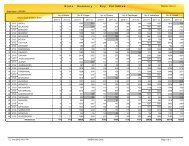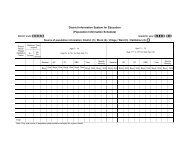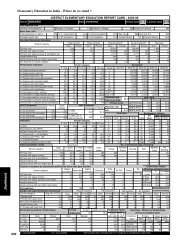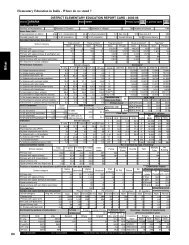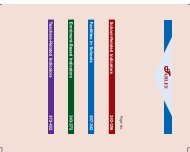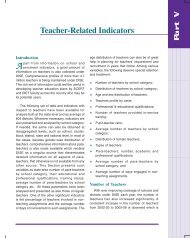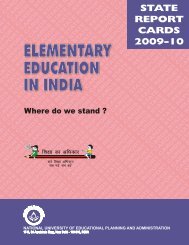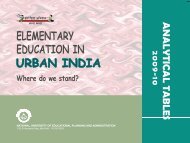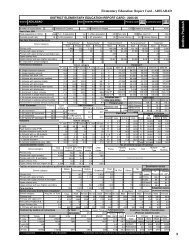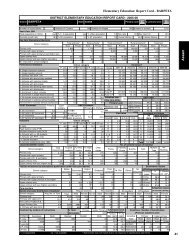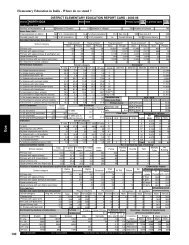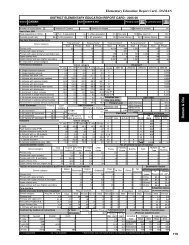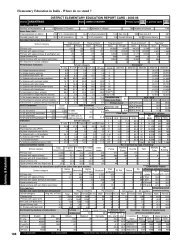Student Flow at Primary Level - DISE
Student Flow at Primary Level - DISE
Student Flow at Primary Level - DISE
- No tags were found...
You also want an ePaper? Increase the reach of your titles
YUMPU automatically turns print PDFs into web optimized ePapers that Google loves.
12 <strong>Student</strong> <strong>Flow</strong> <strong>at</strong> <strong>Primary</strong> <strong>Level</strong>PRATHM all-India survey of out-of-school children. The other majorvari<strong>at</strong>ion is the number of st<strong>at</strong>es th<strong>at</strong> have been covered under differentsurveys and also the frequency of d<strong>at</strong>a collection. While <strong>DISE</strong> covered allthe st<strong>at</strong>es, the ASER: PRATHAM survey covered only 28 out of 35 St<strong>at</strong>es &UTs and confined to the rural areas. The un-covered st<strong>at</strong>es are: J & K,Himachal Pradesh, Uttarakhand, Chandigarh, Delhi, Lakshadweep,Mizoram, Puducherry, Sikkim and Andaman & Nicobar Islands. However, inthe IMRB-Intern<strong>at</strong>ional survey, both the rural and urban areas of all theSt<strong>at</strong>es and UTs have been covered.Before different estim<strong>at</strong>es are compared, it is also important to knowhow the samples upon which estim<strong>at</strong>es are gener<strong>at</strong>ed are drawn. On theone hand, <strong>DISE</strong> estim<strong>at</strong>es are based on d<strong>at</strong>a received from more than 1million institutions, as mentioned above, the other two surveys arehousehold-based surveys. ASER: PRATHAM is based on the d<strong>at</strong>a collectedfrom as many as 191 thousand households, and IMRB-Intern<strong>at</strong>ional from87,874 households. However, ASER:PRATHAM estim<strong>at</strong>es concerning facilitiesin schools, learning <strong>at</strong>tainments and availability of teachers, are basedon only 4,918 schools having Grades I-IV/V and 3,536 schools having GradesI-VIII.The out-of-school children estim<strong>at</strong>ed by IMRB are based upon the projectedpopul<strong>at</strong>ion (in July 2005) obtained by using the average annual compoundgrowth r<strong>at</strong>e between the census years 1991 and 2001. However, basis of6-11, 11-13, 6-13 and single-age of 5 and 6 years projected popul<strong>at</strong>ion isnot provided which has been projected separ<strong>at</strong>ely in the rural and urbanareas as well for boys and girls. Hence, once the more authentic estim<strong>at</strong>esof the clientele popul<strong>at</strong>ion is available; the estim<strong>at</strong>e of out-of-schoolchildren both in the percentage and absolute terms would also be changed.In the backdrop of the above methodological vari<strong>at</strong>ions, a comparison ofdifferent estim<strong>at</strong>es is presented below.ASER-PRATHAM: Percentage Children Enrolled & Not EnrolledThe percentage of children enrolled by type of schools and children notenrolled <strong>at</strong> the all-India level, estim<strong>at</strong>ed by the ASER-PRATHAM, ispresented in Table 2. The percentage is obtained in rel<strong>at</strong>ion to total childrenin an age-group but confined only to rural areas. Thus, all children in anage-group is divided into two parts, namely those who are enrolled andthose who are not enrolled. The st<strong>at</strong>istics gener<strong>at</strong>ed is based on the d<strong>at</strong>acollected between October and December 2005. However, neither theout-of-school children in absolute number is estim<strong>at</strong>ed nor total popul<strong>at</strong>ionin an age-group is projected.




